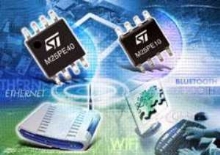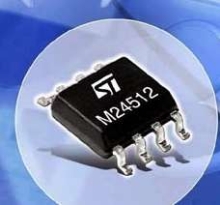
Serial Flash Memories offer data and parameter storage.
Offered in 1-, 2-, and 4-Mbit densities, Series M25PE is accessed through SPI bus, with clock speed of 25 MHz for data transfer. Operating on 2.7-3.6 V, units offer 256 Byte Page Write, 64 kbytes Erase by Block, dedicated device signature, bulk erase instruction, and specific write protection. Memories maintain continuity with serial EPROMs in pin-out and are suited for optical mice and PC...
Read More »Memory Upgrades improve ThinkCentre system performance.
ThinkCentreÃ-® PC2-5300 CL5 Non-Parity (NP) DDR2 SDRAM Unbuffered DIMM (UDIMM) memories enable users to upgrade standard system memory capacity to maximize overall system performance. Featuring max data transfer rate to 5,300 MBps, products are offered in 256 MB, 512 MB, or 1 GB capacities. Memories have serial presence detect and decode functions and come on 240-pin UDIMM with gold-plated...
Read More »Solid State Disk features redundant RAM technology.
Based on IBMÃ-® Chipkill(TM) technology, RamSan-325 non-volatile disk protects databases and other business critical applications from multi-bit errors that can cause data corruption. It includes redundant and hot swappable power supplies, redundant batteries, and 4-disk RAID with hot swappable backup hard disk drives that store data flushed from memory. RamSan-325 can deliver random data at...
Read More »Portable Memory Tokens target medical device applications.
SlimLine(TM) Tokens withstand EtO sterilization process as well as autoclave sterilization at 265Ã-
Read More »
How to Choose the Right Transportation Logistics Partner
Our How To Choose The Right Transportation Logistics Partner eBook is a guide to help customers choose the right transportation solution for their needs.
Read More »Memory Upgrades enhance overall system performance.
Offered in 256 Mb, 512 Mb, 1 Gb, or 2 Gb capacities, PC2-4200 CL4 Non-Parity (NP) DDR2 SDRAM Unbuffered DIMM (UDIMM) memory upgrades enable ThinkCentre(TM) systems to run more programs simultaneously. They have 240-pin UDIMM with gold-plated leads, serial presence detect/decode functions, and offer max data transfer rate to 4,200 MBps. Products are also supported in non-IBM systems that support...
Read More »
Flash Microcontrollers suit low-voltage applications.
Able to deliver up to 10 MIPS at 3 V, 8-bit PIC18F87J10 series is comprised of 10 models that utilize nanoWatt technology for power management while providing linear access to 32-128 Kbytes of onboard Flash memory. Series employs 2 synchronous serial ports, capable of SPI(TM) or I2C(TM), as well as 2 asynchronous serial ports, LIN-capable USARTs. Products are offered with up to 4 Kbytes of data...
Read More »DIMM and Power Cord Options offer system flexibility.
Paired memory DIMMs (Dual Inline Memory Modules) enable users to scale capacity of infrastructure to meet business requirements. Available in 4 models, products let companies purchase memory in increments of 1,024 (No. 1949), 2,048 (No. 1950), 4,096 (No. 1951), and 8192 (No. 1952) Mb. Up to 8 of each DIMM can be used per system. Power cord options are also available on select IBM eServerÃ-®...
Read More »
EEPROM Devices suit I2C and SPI bus applications.
Housed in 4.5 x 3.1 mm TSSOP8 package, Models M95512 and M24512 are 512-kbit devices that use 1.65 V, 0.18 micron EEPROM process technology. Compatible with SPI bus serial interface, Model M95512 offers high-speed frequency of 10 MHz and above with 5 ms write time. Model M24512 features I2C serial interface with 400 kHz clock rate. Both operate in 1.8-5.5 V and 2.5-5.5 V ranges. Units are suited...
Read More »Serial 1 Mbit nvSRAM incorporates real-time clock.
Manufactured in 48-pin SSOP package, STK18TA8 incorporates 40 MHz Serial Peripheral Interface with compatible commands to industry standard 1 Mbit EEPROM. Store to QuantumTrap(TM) Nonvolatile elements are initiated automatically on power down. Featuring single 3 V operation, product has unlimited read, write, and recall cycles as well as clock alarm with programmable interrupts. Other features...
Read More »NOR Flash Memories provide security to protect code and data.
NOR Flash memories with non-volatile Krypto(TM) hardware and software technology allow access to memory content only after mutual authentication between NOR Flash and CPU. To safeguard intellectual property and stored program code, read protection mechanism prevents unauthorized reading of memory or duplication of its data in pirate devices. Sensitive data can be hidden, code can be encrypted, or...
Read More »
Come Alive Organics' Premium Organic Agave Provides a Healthier Choice
Come Alive Organics distributes all-natural, proprietary flavored agave for the food and beverage industry while helping children across the globe. Learn more about our agave products and our one sweet cause in this video and two-page PDF.
Read More »



